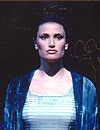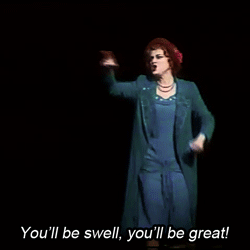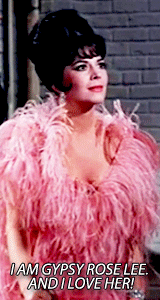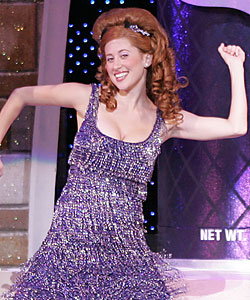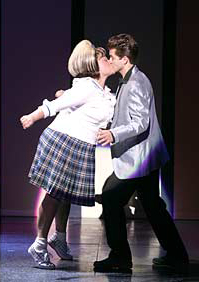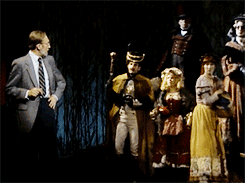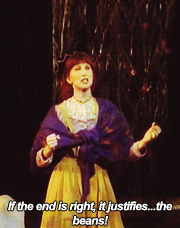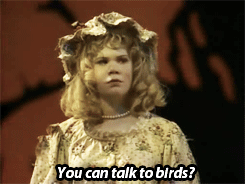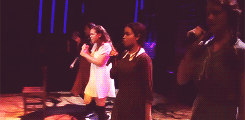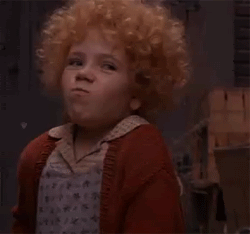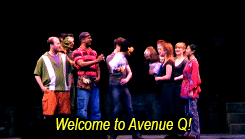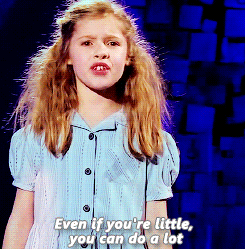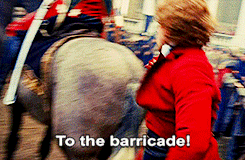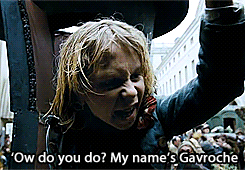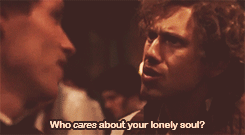Bechdel and Beyond: A Look at Musical Theatre and the Bechdel Test
For those of you who have been reading my blog (all two of you-hi Mom and Dad) you’ve hopefully gathered two things: I am female, and I am a HUGE musical theatre nerd. But something interesting and disturbing was pointed out to me recently by one of my favorite video vloggers, xxjessworldxx: A shocking number of musicals don’t pass The Bechdel Test. I didn’t want to believe it….but then Ithought about it, and I realized he was right….
A lot of musicals, even a few of my favorites, fail to pass the Bechdel Test. Now for those of you not familiar The Bechdel Test (Created by Alison Bechdel, the subject of the musical Fun Home) is a feminist test for books, movies, and yes, plays and musicals. To pass the Bechdel Test, a work has to do the following things.
1. Have at least two named female characters
2. Have said characters have a conversation that…
3. Is not about a man.
There are a LOT of great shows that FAIL the Bechdel Test! But on the other hand, there ARE indeed shows that pass the Bechdel Test! They do exist. So I thought it would be a fun blog post to examine a couple of them, and just examine women portrayed in musicals in general. We’ll take a look at a couple of them.
Disclaimer: This is NOT meant to be a consecutive list. First off, it would take forever to write. Second, I just wanted to highlight a couple that passed the test, and that I liked enough/was familiar enough with to really write about. (And okay, maybe I did lean towards shows that I’ve done and/or shows that Aaron Tveit once did so I could include pics from my shows and Aaron Tveit gifs. So sue me), There are a lot more out there, feel free to add some in the comments section! Also the shows listed are in alphabetical order, so it’s all fair. Third, I’m aware that what constitutes as a “conversation not about a man” is a bit subjective. This is according to my interpretation. Disagree if you will, but you can’t say I never made a disclaimer.
Aida
Year it premiered on Broadway: 2001
Creative team: Elton John (music), Tim Rice (lyrics), Linda Woolverton, Robert Falls, and David Henry Hwang (book)
Synopsis: Based on the Verdi opera, tells the story of forbidden love between feuding countries, and ends with a lot of death.
Bechdel requirements: At least two named female characters:
(Deborah Cox)
Aida: Headstrong princess of Nubia, kidnapped by Egyptian guards who remain unaware she is the princess until the end of the show. Falls in love with Radames, captain of the guard, creating an Egyptian Romeo and Juliet. Very well developed character. Makes a lot of fatal mistakes but ultimately has good intentions and good morals and does her best to be a good leader to her people.
(Idina Menzel)
Amneris: Essentially the show’s narrator. The princess of Egypt, she starts the show as a seemingly shallow, appearance obsessed little brat. As the show progresses, her eyes awaken to the harsh realities of the war being waged with Nubia, and her father’s illness forces her to face the reality of marrying her fiancé Radames and becoming queen. (Yeah, that’s the same guy Aida’s in love with…..TRIANGLE!) Both women are excellent, well written characters that I consider positive female representation in musicals.
Conversation not about a man: Aida and Amneris’s relationship is not the focal point of the show by a long shot. However, they do get a charming moment together in the middle of act one. They both talk about the pressures and strains of being a princess and therefore a role model, though at this point Aida is held captive and having to pretend like she doesn’t actually know what she’s talking about when in reality she knows all too well.
“My Strongest Suit-Reprise”
Gypsy
Year it premiered on Broadway: 1959
Creative team: Jule Styne (music), Stephen Sondheim (lyrics), Arthur Laurents (book).
Synopsis: Based on the life of Gypsy Rose Lee, tells the story of Mama Rose and her relationship with her daughters, and how her obsession with getting them into show business affects them.
(Ethel Merman and Company)
Bechdel requirements: At least two named female characters:
(Bernadette Peters)
“Mama” Rose Hovick: The story’s main character, abandoned by her own mother, has a multitude of husbands she’s left behind. Has two daughters who she’s trying to make Vaudeville stars. Overbearing, domineering, and one of the juiciest stage roles for a woman that exists.
(Natalie Wood)
Louise “Gypsy Rose Lee” Hovick: The eldest daughter, ignored very much growing up for the more talented and charismatic June. Content at the beginning to roll along with whatever her mother says. After accidently landing in burlesque, she discovers she’s actually quite good at it and makes a name for herself, finally standing up to Rose.
(Leigh Ann Larkin)
“Dainty” June Hovick: The younger daughter. Very talented, blonde, your classic beautiful leading lady. Very resentful of Rose’s treatment of her, eventually elopes to escape her.
Other named female characters: Tessie Turra, Miss Mazzepa, Electra, Agnes/Amanda and the rest of the “Hollywood Blondes.
Conversation not about a man: Several. Probably my favorite is between June and Louise, wishing that Rose would marry and settle down via the song “If Momma Was Married”. Then there’s the famous fight between Louise and Rose towards the end of the show, where Louise finally states her case and defends her lifestyle to her mother.
“If Momma Was Married” from the 1962 movie of Gypsy
Hairspray
(Most of these photos are going to be from The Little Theatre of Jefferson City’s production of Hairspray from 2011. I was a techie for that. Photo credit to Jennifer Bish)
Year in premiered on Broadway: 2002
Creative Team: Marc Shaiman (Music and Lyrics), Scott Whitman (Lyrics), Thomas Meehan (Book), Mark O’Donnell (Book)
Synopsis: Based on the John Waters film, sixties teenager Tracy Turnblad becomes a local celebrity, gets the guy, and tackles important social issues too!
Bechdel requirements:
At least two named female characters:
(Brynn Shaw)
Tracy Turnblad: The story’s protagonist. Awesome female role model, stays true to herself, and while she does fall in love, doesn’t let wanting a man getting in the way of more important things, like helping combat segregation at the local TV station where she’s a star. Speaking of which, she makes it onto TV and becomes talk of the town despite being chubby and awkward. She has her dreams and achieves them, making her one heck of a woman! 
(Brian Harper)
Edna Turnblad: Yes, Edna is played by a man, but she is still one awesome woman. Throughout the show she gains confidence in herself and gives herself permission to be the big, blonde, and beautiful woman she is. A lot of that comes from the encouragement of Tracy. There are a lot of negative mother/daughter relationships in musical theatre, so it’s nice to see a good one!
(Caissie Levy)
Penny Pingleton: Tracy’s shy, awkward friend, under the thumb of her neurotic mother. But she too finds her wings, partially through her forbidden romance with Seaweed, but I like to think that Penny comes to her own by her own will as well. She’s a lot of people’s favorite character, and with good reason.
(Regina Blanchard-Walker)
Motormouth Maybelle: I’ve always had a soft spot for Motormouth. Not only is she female, but she’s also black, which in the sixties in America meant a lot of obstacles in your path. Despite all that, she’s still on her own two feet as a TV personality and business woman. (And a killer sense of style as well). She helps Tracy and the rest of the gang stand up for what’s right, more than willing to give encouragement to the other women in her life. Her daughter Inez is pretty cool too, for having the same strong spirit and ethics as her mother. (Another positive mother/daughter relationship!) 
(Kaitlin Niewoehner and Debra Walker)
Velma Von Tussle and Amber Von Tussle: I lumped them together because they essentially serve the same purpose: Tracy’s (and just about everybody else’s) roadblocks. They do everything in their power to exclude anyone they don’t deem fit (anyone who isn’t “thin”, “attractive”, or white). Granted, not the most positive portrayal of women out there, but their presence in the show is still important. The world is full of real life Ambers and Velmas, and I think it’s great to show people like Tracy and Edna overcome their abuses without stooping to their level. (Granted, Tracy did say Amber had “acne of the soul” but she had it coming).
Other named female characters: Inez, The council girls, Prudy Pingleton (Penny’s mom)
Conversation not about a man: This musical has a ton! Tracy talks to Penny and her mother about wanting to be on the Corny Collins show, Tracy convinces Edna to come out of the house and embrace the sixties, Tracy talks with Motormouth Maybelle about protesting the studio and fighting for what’s right. Yes, Tracy has conversations about men too, specifically Link Larkin….….
(Sorry, couldn’t resist the urge to use an image of young Aaron Tveit in Hairspray. That is how I first discovered him FYI…but that’s a different story.) …..where was I? Oh yes, Tracy. But she’s not by any means defined by her man. I’m barely scratching the surface here, but long story short, this show passes the Bechdel Test with flying colors!
“Mama, I’m a Big Girl Now”
Into the Woods
Year it Premiered on Broadway: 1988
Creative team: Stephen Sondheim (music and lyrics), James Lapine (book)
Synopsis: Grimm’s fairy tales, specifically Cinderella, Rapunzel, Little Red Riding Hood, Jack and the Beanstalk, and others are all intertwined via a baker and his wife trying to unravel a curse left on them by a witch. Don’t let the cheerful synopsis fool you: by the end of Act Two there’s a body count almost as big as Sweeney Todd.
(I admit, this show has been on my brain a lot because I’m on crew for a production of it in my hometown-more on that later. But it does, indeed, pass the Bechdel Test, so read on!)
Bechdel requirements:
At least two named women: It’s a little tricky with Into the Woods, since a lot of the significant characters, both male and female, go by titles rather than names. (Baker’s Wife, Witch, etc.) It’s debatable whether or not that counts as a name, but there are still enough ladies with “actual names” for it to meet this Bechdel requirement. (But I’m going to talk about some of the ones identified by title too, because they’re still pretty dang important.)
(Bernadette Peters)
The Witch: Yes, the big cheese of the show is a woman. She sends the baker and his wife out on the quest to bring her the objects that will make her beautiful again, which she lifts the curse for them in exchange. Honestly, if you want a good description of the witch just listen to what she says in “Last Midnight” and you’ll understand her character. Is she the best role model? Well, she’s borderline abusive to her surrogate daughter, and she tries to feed Jack to the giant, so maybe not. But she’s still a powerful and juicy female character.
(Joanna Gleason)
Baker’s Wife: Throughout the show she proves herself to be self-sufficient, resourceful, and brave time and time again. The baker would be the first person to admit that she truly wears the pants in the relationship, and in fact he does. It’s no wonder it’s one of the most highly coveted musical theatre roles for women. Of course, her morals aren’t always the best, she deceives Jack to get his cow and gets….um, well…..very friendly with Cinderella’s Prince, for which she definitely gets comeuppance. But to me, her flawed character makes her all that more textured and dynamic. It’s the stereotype for women in fairy tale women to be bland and without personality, and she more than definitely breaks that mold (Which I believe was part of the point of the show).
(Kim Crosby)
Cinderella: Cinderella has been done so many times, but this Cinderella is my favorite, especially when played by the beautiful Kim Crosby (Who I freaking know….what is my life?!) or by Sarah Dent, who is playing her in the production I’m helping out with. But I think of all the ones I’ve seen, this interpretation of Cinderella is my favorite. She starts out slaving to her step mother and step sisters, trying to be the kind person her mother taught her to be. So she lacks a bit of a backbone, but she still has enough oomph to make it to the festival. As far as her involvement with the Prince, I think she sums it up best when she says “Wanting a ball is not wanting a prince!” I love that they portray her with the vulnerability of not knowing what she wants instead of just magically falling in love with the prince in one night. Eventually he finds her and at first it looks like all is well…until a giant visits the kingdom and her prince turns out to be a two timing jerk. But she doesn’t take either set back lying down. She ditches the prince and helps team up with the others to beat the giant, and then moves in with the Baker. (Is it really weird that I ship Cinderella and the Baker? Anyone else? Just me? Okay, moving on).
(Danielle Ferland)
Little Red: In my opinion, she’s one of the most dynamic characters of the story. She stars off as this naïve, slightly irritating little girl, but the events with the wolf and with the giant make her grow up a bit. She becomes a bit wiser to the world, but she’s not completely hardened to the world either. She’s able to maintain some of her sweetness, innocence, and sass despite it all. Throughout the show, most of her actions can be perceived as good, but without being phony about it. (Okay maybe stealing all the Baker’s sweets wasn’t very good, but hey, nobody’s perfect).
(Barbara Byrne)
Jack’s Mother: This woman seriously doesn’t get enough love, so I’m gonna talk about her for a bit if I may. Single mom, doing everything she can to ensure her son’s and her survival. A bit hysterical and frantic, but to be fair I would be too if my kiddo was fighting giants and they ended up in my backyard. She’s a fierce mama bear who goes out defending her cub. Everything she does is for her boy, so way to go Jack’s mom.
Other named female characters: Rapunzel, Florinda, Lucinda, Snow White, Sleeping Beauty
Conversation not about a man: Cinderella has her song with the spirit of her mother asking to go to the festival, Rapunzel and the Witch talk about their relationship and her desire to leave the tower, and a few others are scattered throughout the show. I think my personal favorite is the conversation between Little Red and Cinderella leading into “No One Is Alone”. It’s actually one of my favorite moments in the show.
“No One Is Alone”
Legally Blonde
(Most of these photos will be from my production in 2011. Photo credit to Andrew Richmond)
Year it Premiered on Broadway: 2007
Creative Team: Lawrence O’Keefe and Nell Benjamin (Music and lyrics), Heather Hach (book).
Synopsis: Based on the MGM film, California sorority girl Elle Woods follows her man to Harvard University, and makes a remarkable journey of self-discovery.
Bechdel requirements:
At least two named female characters:
(Erica Ranay)
Elle Woods: The story’s pink protagonist. Even at the top of the show she’s sharp and badass, but she just hasn’t thought to apply it to things outside of sorority events and fashion yet. Warner breaking up with her leads her to go where no Delta Nu has gone before and tackle law school. With the help of some other awesome women, her dog Bruiser, and the charming Emmett, she proves everybody wrong and makes one great lawyer.
(Reagan Freeman)
Paulette: Elle’s hairdresser and companion. (And she’s my older sister’s musical spirit animal). She too is awesome and badass, but the poor gal just doesn’t see it in herself at the top of the show. But as the plot unfolds, she too finds her inner strength to get back her dog from her ex and lure in a new man with the bend and snap. Hilarious and relatable, Paulette is a great addition to the awesome women of this show.
(Margaret Graham, Caleb Forrest)
Vivienne Kensington: Starts out as Elle’s arch nemesis, the woman her man ditched her for. Vivienne at first sees Elle as an insignificant dumb blonde trying to steal her man, but is willing to admit she’s wrong when Elle proves otherwise. (Can we talk for a moment how awesome that is?) She too is a strong female character not defined by her relationship to another man, who knows her stuff and how to use it.
Other named female characters: Brooke Wyndam, Chutney Wyndam, Kate, Enid Hoops, Margot, Serena, Pilar
Conversation not about a man: Vivienne’s apology/pep talk to Elle, Elle getting Brooke’s alibi, the Delta Nu girls helping Elle into Harvard, especially Kate (who I played! Also Chutney).
“Legally Blonde Remix”
Mary Poppins
(Photos are mostly from my production. Photo cred goes to Andrew Richmond)
Year it Premiered on Broadway: 2006
Creative Team: Robert B. Sherman and Richard M. Sherman (Music and lyrics), George Stiles (Additional music), Anthony Drewe (Additional lyrics), Julian Fellowes (Book).
Synopsis: Based on the stories of P.L. Travers and the Disney film, Mary Poppins is the magical nanny that brings a new way of life to the Banks household with a spoonful of sugar and a whole lot of fun.
This show has been on my mind a lot as well, because I just did it. I was in the ensemble, and got to wear a dress and hat. (Several people in the cast said I resembled Rose Dewitt-Bukkater in Titanic, which made me very happy).

Bechdel Requirements:
At least two named female characters.
(Tori Stepanek-yes, our Mary flew!)
Mary Poppins: The title character magical nanny extraordinaire herself! It’s kind of hard to talk about somebody who’s practically perfect. But she’s the last bow and is the source of all good things, and you’re lying if you say you don’t want her as her nanny.
(Kit Meyer)
Winnifred Banks: The other lady of the house. Unlike the movie she is not a suffragette, but a house wife trying to make her husband happy, but often at the cost of her own happiness. Mary Poppins helps the family work together and function as one unit, and Winnifred grows considerably as a result. She and George are able to finally communicate and function as equals.
(Andrea Baker)
Jane Banks: Along with her brother Michael, Mary helps the kiddos grow from little brats to lovely little children. Their relationships with their parents become healthier and stronger, and all is well.
Other named female characters: Mrs. Brill, Mrs. Corry, Miss Lark, The Bird Woman, Queen Victoria
Conversation about something other than a man: Mary gives her lessons to Jane and Michael about life. Mrs. Brill and Winnifred have conversations about running the house. Mary tells off Mrs. Andrews and chats with Mrs. Corry. Mary helps talk Mrs. Banks into going to help George out at the bank.
“Anything Can Happen If You Let It”
Next to Normal
Year it Premiered on Broadway: 2009
Creative Team: Tom Kitt (Music), Brian Yorkey (Book and Lyrics)
Synopsis: Looks at Diana Goodman and life with mental illness, and how it affects her family. Bring tissues.
Bechdel Requirements:
At least two named female characters:
(Alice Ripley)
Diana Goodman: The mother of the family. Beautiful, intelligent, suffer of bi-polar depression. Hallucinates Aaron Tveit.
Thankfully she has an amazing, loving husband, Dan, who sticks with her through all of it. By the end of the show though, she realizes that she needs to fight her demons alone and leaves him. (Cue ugly sobs).
(Jennifer Damiano)
Natalie Goodman: Diana and Dan’s teenage daughter. Uber intelligent, gifted pianist, major perfectionist. Feels like she’s always in the shadow of her brother, who died before she was born….and whom her mother is hallucinating as a teenage boy. (Hey, if my brother was as perfect as Aaron Tveit, I would feel pretty insecure too).
She too finds an incredibly supportive loving man who supports her through thick and thin. (Seriously, can somebody send me a Dan or a Henry already? Or just Aaron Tveit?)
But even without Henry, she’s incredibly tough dealing with her mom’s struggles and her own personal demons.
Conversation not about a man:
Diana and Natalie talk past each other quite a bit in the show, but none of those conversations are about a man. Natalie almost tells her mom about Henry, but then chickens out. But in Act Two, Natalie takes her mother to the hospital and the two of them have a sit down, gut wrenching heart to heart. They say everything to each other they never could before, and resolve to strive for the best life they can make.
“Maybe/Next to Normal”
Pirate Queen
Year it Premiered on Broadway: 2007
Creative Team: Claude-Michel Schonberg (Music and book), Alain Boubil (lyrics and book), Richard Maltby Jr. (English lyric adaption and book), John Dempsey (English Lyric Adaption)
Synopsis: Based on true events, Pirate Queen tells the story of Grace O’Malley, the woman who becomes the first female chieftain of her sea faring Irish clan. With the help of her crew, her love interest, and Queen Elizabeth the I, she saves her clan and makes a name for herself in the history books.
Bechdel Requirements:
At least two named female characters
(Stephanie J. Block)
Grania “Grace” O’Malley: The chief protagonist, daughter of the O’Malley’s clan leader. She grew up on a ship, being trained in swords and sea faring. She takes over for her father in his declining health and leads the O’Malley’s despite her gender. (Her “I Want” song is one of the most fantastic feminist anthems in history, and it would be a shame to have a post on something as pro-woman as the Bechdel Test and not include this song-and this is a really beautiful version).
Anyway, she agrees to an arranged marriage with Donal O’Flaherty (JERK) to stop feuding between the two clans, but ultimately refuses to put up with his nonsense and leaves him to rule the clan on her own after her father’s death. (Although she does strike up handsome childhood friend turned beau named Tiernan. But clearly she does pretty well without a man too).
(Linda Balgord)
Queen Elizabeth I: The other major female in the story, she too is a woman in charge. However, rather than embracing her womanhood like Grace, she does everything in her power to make herself seem like a man so that people will take her seriously as a ruler. She’s intrigued by the news of this female ship captain, but that doesn’t stop her from conquering Ireland and the clans within it, including Grace’s.
Conversation not about a man:
Towards the end of the show, Grace requests and audience with Queen Elizabeth to make amends between England and Ireland. Ultimately, Elizabeth agrees and they meet “not as chieftain, not as queen, woman to woman, face to face”. They come to an agreement, and Ireland is made free again.
“Woman to Woman”
Spring Awakening
(Okay real quick before we get started can I just say how freaking excited I am for the revival!???!)
Year it Premiered on Broadway: 2006
Creative Team: Duncan Sheik (Music), Stephen Sater (Lyrics and book)
Synopsis: Based on the play by Frank Wendekind. 19th century Germany, small provincial town, teenagers discover their sexuality under repressed conditions. All accompanied by really awesome rock music.
Bechdel Requirements:
At least two named female characters:
(Elizabeth Judd)
Wendla Bergmann: The story’s primary female character. Young, curious, inquisitive of her body and the changes it’s going through. Unfortunately the adults in her life are unwilling to give her the answers she’s looking for, so she ends up finding out the hard way with disastrous results. But her ignorance by no means makes her stupid. She’s very astute with an enormous heart. It really is a tragedy she doesn’t make it past fourteen because I have a feeling she would have been one fantastic woman.
(Lauren Pritchard)
Ilse Neumann: My personal favorite character in the show. She’s introduced as the faraway friend of Wendla and her gang, who ran away to escape her abusive household and is now living in the artists’ colony with the Bohemians. She runs into Moritz right before he kills himself, having run away again from the life of prostitution she was living in Priopia. She begs for Moritz to come with her to relive their childhoods once again, but he declines, and she leaves, despondent. Melchior reaches out to her in the form of her letter, begging her to help reunite him with Wendla, not knowing that she has died. Ilse is pretty cool, and she’s standing on her own two feet despite everything she’s been through at such a young age. I was a swing for this show, and I played Ilse in a few rehearsals, which was an absolute dream come true for me.
(My production-I’m way at the far right end)
(Maggie Hunter and company)
Martha Bessel: Friends with Wendla. She goes through sexual abuse from her father, which she tells her friends about, but begs them not to tell anyone. She also has a crush on “that sad, soulful, sleepyhead Moritz Stiefel”. (I’m with you girl!)
Other named female characters: Thea, Anna, Fanny Gabor (Melchior’s mom), Fraulein Knuppledick (the headmistress), Fraulein Grossenbustenhalter (the piano teacher-and her name translates literally as “over the shoulder boulder holder which I find pretty hilarious)
Conversation not about a man: At the top of the show, Wendla begs her mother to give her the facts of life. Nowhere in that conversation does her mother mention how the man plays in that process, so I’d say that counts. Martha confesses to her friends about her abuse. That’s a bit iffy since she does bring up her father in that conversation, but I personally think that’s more about the abuse than anything else so I’m counting it. That leads into a duet between Martha and Ilse about their experiences in that area with “The Dark I Know Well”. Once again, men do come up, but it’s more about how they feel about what’s going on rather than about their abusers themselves. Towards the end of the show, Martha reads the rest of the girls (sans Wendla, because she’s died) the letter from Melchior. Melchior does come up obviously, but it’s more about how Wendla has died and he doesn’t know.
“The Dark I Know Well”
Wicked
Year it Premiered on Broadway: 2003
Creative Team: Stephen Schwartz (Music and lyrics), Winnie Holzman (Book).
Synopsis: Based on the novel by Gregory Maguire….which is based on The Wonderful Wizard of Oz….which pretty much makes Wicked a really successful fan fiction. (Take THAT Fifty Shades!)
Bechdel Requirements:
At least two named female characters:
(Willemijn Verkaik)
Elphaba Thropp: I literally cannot say enough things about this about this character. She’s one of the best written, well developed, relatable and all around awesome musical theatre heroines of this century. There’s a reason every musical theatre girl wants to play her, and “Defying Gravity” is on the “Do Not Sing at Auditions” list. She wears her heart on her sleeve, stands up for what’s right even when it means personal loss, and is not afraid to be different. (Of course, being born with green skin she doesn’t have much of a choice, but she freaking rocks it). She refuses to let other people, men or women, decide her life for her, and ultimately remains true to who she is even when the world tells her she’s wicked. She does have a romantic interest, and it adds to the plot without being the plot, which is refreshing. Gold star for you Elphaba Throp, you’ve earned it.
(Alli Mauzey)
G(a)linda Upland: It’s easy for Glinda to be hidden in Elphaba’s shadow, but she’s a fantastic character as well when played correctly. I’ve seen Glinda done too serious, and I’ve seen her done too light and fluffy too. She IS a funny and beautiful woman, but by the end of the show she’s also a changed woman with regrets and pain in her heart, but she’s still there and still trying to do what she knows best to do. One of the things I love about Wicked is that Glinda and Elphaba both grow through their friendship and experiences together, which is not something that’s the focal point in many shows. I think Ginda is best summed up during the song “Thank Goodness”. She’s singing “I couldn’t be happier”, because she thinks she should be happy. She has what she wants, but she’s learned that sometimes the things you think you want come with irreversible consequences. Ultimately she promises Elphaba to continue where she left off in trying to save the talking animals, because Oz, much like our world, is more likely to listen to the pretty blonde girl rather than the outcast.
(Carol Kane)
Madame Morrible: There’s a reason the fandom calls her “Morrible the Horrible.” First introduced as the mothering headmistress who sees the potential in Elphaba to become grand vizier to the Wizard. By the end of act one, we see her true colors and know that her plan was to exploit Elphaba’s powers so the Wizard would move her up in the world. She uses her new found power as press secretary to create the image of the “Wicked Witch of the West” by spreading vicious rumors about Elphaba. To me what’s even worse is when she users her supernatural skills to kill Nessarose in order to bring Elphaba down…which also brings Dorothy into the picture. She’s an example of a woman who is powerful, and abuses such power. Thankfully Glinda puts her booty in jail. (She had it coming…..she had it coming….)
(Liana Hunt)
Nessarose Thropp: It seems what whenever I see Wicked, (Which as of right now is six times, with at least one more time by the end of the year) I either love or hate Nessarose, and it all depends upon how she’s portrayed. But my favorite portrayals of her are the more vulnerable Nessarose. At the top of the show, it’s clear that she’s the favorite of the family despite being crippled. Between her disability and her father being so overprotective, I’d say she’s had a very sheltered life. In my mind, that would make the sudden shock of A. Elphaba becoming the Witch of the West B. Her father dying C. Suddenly becoming governor and D. Boq still refusing her advances all that much more overwhelming. I don’t think she’s purposely trying to hurt anyone, she just got dealt too much too soon and didn’t know what to do with it. She naively holds onto the delusion that Boq loves her, but is holding back because of her being in a wheelchair. (On a side note, I think Boq’s story is just as if not as sad. I think if he actually got to spend five minutes he would be disillusioned, but that’s all he has to hold onto while being held captive in the governor’s mansion, and ultimately it costs him dearly.) She gets even more power through Elphaba’s spell and the Grimmerie, but she almost kills Boq chasing after a hopeless dream. But the one thing I can’t forgive Nessarose for is for blaming Elphaba for Boq’s transformation and not admitting to her part of it. Elphaba keeps giving and giving and nobody ever thanks her for it. But for the most part, I think Nessarose is a tragic character who could have been a great ruler, but in the end made a few too many fatal mistakes. That being said, she still didn’t deserve to be killed just to reel in her sister.
Conversation not about a man:
This show is chock full of them thanks to having not one but two main female protagonists. The girls talk about their mutual hate for each other in “What is This Feeling”, Galinda’s room mates talk her into giving Elphaba the pointed black hat, Elphie and Glinda enjoy The Emerald City and Elphaba talks to Glinda about how accepted she finally feels, Madame Morrible gives Elphaba the Grimmerie and guides her how to use it, Glinda and Elphaba at first argue in “Defying Gravity” about how the other has screwed up, but then turn to each other, Elphaba begs Glinda to come with her but she ultimately refuses and they depart wishing each other the best….and that’s all in Act One! Cut to Act II, Nessarose and Elphaba argue about how Nessa feels abandoned, and Elphaba apologizes to her for not doing enough for her, Madame Morrible reveals to Glinda how Nessarose really dies and threatens her to go along with the “let’s kill Elphaba” propaganda….and then there’s “For Good” where the girls sing about their friendship (cue Deborah crying hysterically), and then finally Glinda taunts Madame Morrible as she’s locked in jail. In terms of conversations not about a man, this show is a feminist fantasy.
Wait….I almost finished the section about Wicked and I have yet to use an Aaron Tveit picture…shame on me…
Ah, that’s better.
“For Good”
Well, there you have it: ten musicals that pass the Bechdel Test! Just for kicks and grins, I’m going to mention another ten just to say that there are more out there:
Annie
Avenue Q
Beauty and the Beast
Fun Home
Heathers
In the Heights
Love Never Dies
Matilda
Rent
Violet
Like I said, this is by no means a comprehensive list, but it proves that there are indeed shows that pass the Bechdel Test. With that in mind, while doing my research for this post, I discovered a lot of shows that for whatever reason don’t pass the best, but they still have awesome female characters and/or positive representations of women. Could that be a future blog post?
Maybe….just maybe… in the mean time, peace out girl scouts. Stay classy.





